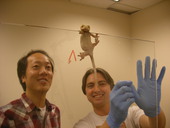Highlight
Comparing gecko feet to a bio-inspired adhesive in an interdisciplinary teaching laboratory
Achievement/Results
In a new interdisciplinary teaching laboratory, students compare nature’s remarkable adhesive found on gecko feet directly to a bio-inspired, engineered adhesive. With support from the National Science Foundation’s Integrative Graduate Education and Research Traineeship (IGERT) program (http://ciber-igert.berkeley.edu ), small teams of biology and engineering students are learning how to collaborate on cutting-edge research problems. Interdisciplinary training takes place in Berkeley’s Center for interdisciplinary Biological-inspiration in Education and Research (CiBER; http://ciber.berkeley.edu ) that currently hosts 32 faculty from 7 departments.
Biologist and Principal Investigator Robert Full discovered that when geckos race up a wall at a meter per second they uncurl and peel their toes in just milliseconds. This unusual behavior results from the fact that they use a fibrillar adhesive composed of arrays of millions of hairs. A gecko, such as the Tokay, has toes with approximately 20 rows of leaf-like micro-rugs called lamellae. Each lamella has thousands of hairs, which totals to approximately 200,000 hairs per toe. Each hair has up to a 1,000 split-ends with sizes near 200 nm. The gecko’s natural nano-tech fibrillar adhesive sticks not by interlocking, suction or glue, but by intermolecular forces alone. Given the complex hierarchical structure, it remains a mystery as to how much of the adhesive is required to contact the surface. Do only some of the lamellae, hairs or split-ends contact or do they all share the load?
Engineer, Co-Principal Investigator, and leader in adhesive design, Ron Fearing built a simpler version of the fibrillar adhesive to begin to have students answer the question in the teaching laboratory. He fabricated polydimethyl siloxane (PDMS) into micro-posts or microfibers with only a single tip. Fearing designed an apparatus that illuminated the side of a glass slide so that contact area could be measured. As contact area increases, white spots of light become visible using one of CiBER’s high-speed video cameras and increase in size. In the first laboratory period, students rigorously tested the artificial adhesive by increasing the shear load using a simple pulley system with adjustable weights. Preliminary results show an increase in contact area as shear load increased, but the distribution of load appears complex even in the simple artificial adhesive.
In the second laboratory period, IGERT trainees and their teammates measured the contact area of a Crested gecko’s foot as the animal hung on a wall, and then increased its shear force by accelerating from a standstill or running upwards. Surprisingly, only very small areas of the gecko’s toes or lamellae contact the surface compared to the artificial adhesive. This likely results from the hierarchy nature of the gecko adhesive. More tips on a given hair may attach without the contact area increase necessarily being reflected at the micro-scale, but more study is required. IGERT trainees have the option to continue this research outside of the laboratory class leading to an original publication.
Designing adhesives as effective as seen in nature requires interdisciplinary teams of biologists and engineers discovering fundamental principles and translating them into a revolutionary product. Educational experiences must explicitly train students how to contribute to and benefit from other disciplines if we are to meet these future challenges.
Address Goals
Learning. Current challenges in science, engineering, industry and society demand research-based skills as well as the ability to collaborate on diverse, interdisciplinary teams, but this is seldom taught explicitly. Our researched-based teaching laboratory focuses on teaching how to collaborate in an effort to translate biological discoveries into engineered devices, and to apply new engineering approaches to generate hypotheses and tools for biological research. To sustain the most effective interdisciplinary collaborations, engineers need to know how their discipline can advance biology and biologists need to learn how the principles they are discovering by studying nature can be generalized to provide inspiration for engineering design. The objective of the interdisciplinary program is to equip IGERT trainees planning careers in research, education and industry with the personal and technical skills needed to communicate effectively across disciplines and to collaborate in creative research and project design.
Our new research-based teaching laboratory provides an environment that fosters interdisciplinary collaboration in the context of original discovery. The new gecko laboratory takes advantage of an often-cited exemplar of biomimicry. Learning from nature captures the attention of not only IGERT trainees, but also young and old alike. This semester PI Full and Co-PI Fearing participated as contest designers and judges in the National Kids Science Challenge. The theme of bio-inspired designed produced over 1,500 detailed entries from 3rd to 6th grades with some of the most creative designs imaginable.
Discovery. Our research-based teaching laboratory exercise on comparing gecko and artificial adhesives shows that learning and discovery can and should be combined. The best learning environment is motivated by the potential of transformative discoveries that can be translated into the disruptive technologies of the future.
Our laboratory exercises are highly structured, but not “cookbook.” Teams of students do not conduct the same experiment with duplicated equipment at the same time with an expected “right” answer. Approximately 20-25 students in teams of 4-5 conduct experiments using state-of-the-art research equipment. Each team has two 3-hour class periods to conduct experiments. A team rotates to a new station each week. After becoming familiar with the equipment and procedures, they are given a problem thought to be solvable based on lectures and readings. We intentionally design the laboratory so that their results do not meet their expectations, often because they must consider another parameter. In the second laboratory using the same station, the team must design its own simple experiment to explain more of the data. Often these experiments represent novel research contributions that when followed up can be published.







